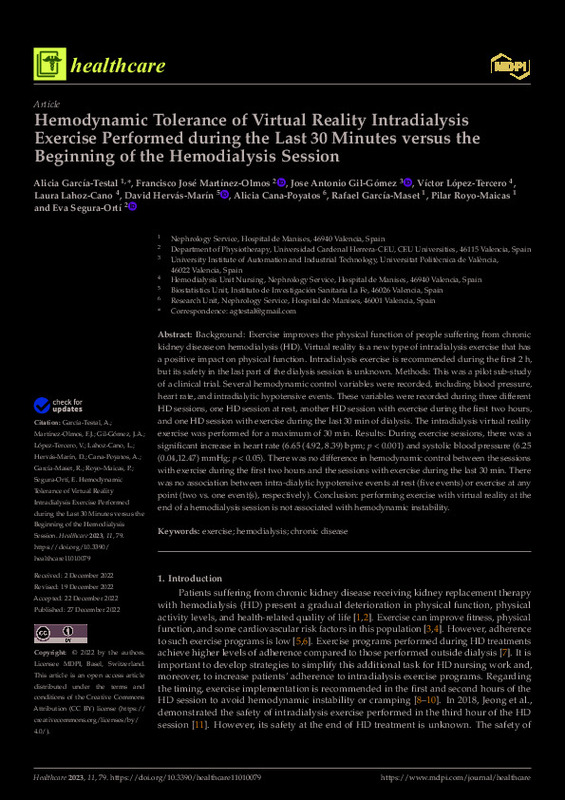JavaScript is disabled for your browser. Some features of this site may not work without it.
Buscar en RiuNet
Listar
Mi cuenta
Estadísticas
Ayuda RiuNet
Admin. UPV
Hemodynamic Tolerance of Virtual Reality Intradialysis Exercise Performed during the Last 30 Minutes versus the Beginning of the Hemodialysis Session
Mostrar el registro sencillo del ítem
Ficheros en el ítem
| dc.contributor.author | García-Testal, Alicia
|
es_ES |
| dc.contributor.author | Martínez-Olmos, Francisco José
|
es_ES |
| dc.contributor.author | Gil-Gómez, José-Antonio
|
es_ES |
| dc.contributor.author | López-Tercero, Víctor
|
es_ES |
| dc.contributor.author | Lahoz-Cano, Laura
|
es_ES |
| dc.contributor.author | Hervás-Marín, David
|
es_ES |
| dc.contributor.author | Cana-Poyatos, Alicia
|
es_ES |
| dc.contributor.author | García-Maset, Rafael
|
es_ES |
| dc.contributor.author | Royo-Maicas, Pilar
|
es_ES |
| dc.contributor.author | Segura-Ortí, Eva
|
es_ES |
| dc.date.accessioned | 2024-01-10T19:03:38Z | |
| dc.date.available | 2024-01-10T19:03:38Z | |
| dc.date.issued | 2023-01 | es_ES |
| dc.identifier.uri | http://hdl.handle.net/10251/201744 | |
| dc.description.abstract | [EN] Background: Exercise improves the physical function of people suffering from chronic kidney disease on hemodialysis (HD). Virtual reality is a new type of intradialysis exercise that has a positive impact on physical function. Intradialysis exercise is recommended during the first 2 h, but its safety in the last part of the dialysis session is unknown. Methods: This was a pilot sub-study of a clinical trial. Several hemodynamic control variables were recorded, including blood pressure, heart rate, and intradialytic hypotensive events. These variables were recorded during three different HD sessions, one HD session at rest, another HD session with exercise during the first two hours, and one HD session with exercise during the last 30 min of dialysis. The intradialysis virtual reality exercise was performed for a maximum of 30 min. Results: During exercise sessions, there was a significant increase in heart rate (6.65 (4.92, 8.39) bpm; p < 0.001) and systolic blood pressure (6.25 (0.04,12.47) mmHg; p < 0.05). There was no difference in hemodynamic control between the sessions with exercise during the first two hours and the sessions with exercise during the last 30 min. There was no association between intra-dialytic hypotensive events at rest (five events) or exercise at any point (two vs. one event(s), respectively). Conclusion: performing exercise with virtual reality at the end of a hemodialysis session is not associated with hemodynamic instability. | es_ES |
| dc.description.sponsorship | Funding included a research project (PID2019-108814RA-I00) supported by the Spanish Government 'Ministerio de Ciencia e Innovacion', a research prize awarded by the nonprofit organization Fundacion Renal Tomas de Osma, as well as from a research grant (IDOC 17-19 and PPC14/2017) awarded by the Universidad Cardenal Herrera CEU. | es_ES |
| dc.language | Inglés | es_ES |
| dc.publisher | MDPI AG | es_ES |
| dc.relation.ispartof | Healthcare | es_ES |
| dc.rights | Reconocimiento (by) | es_ES |
| dc.subject | Exercise | es_ES |
| dc.subject | Hemodialysis | es_ES |
| dc.subject | Chronic disease | es_ES |
| dc.subject.classification | LENGUAJES Y SISTEMAS INFORMATICOS | es_ES |
| dc.subject.classification | ESTADISTICA E INVESTIGACION OPERATIVA | es_ES |
| dc.title | Hemodynamic Tolerance of Virtual Reality Intradialysis Exercise Performed during the Last 30 Minutes versus the Beginning of the Hemodialysis Session | es_ES |
| dc.type | Artículo | es_ES |
| dc.identifier.doi | 10.3390/healthcare11010079 | es_ES |
| dc.relation.projectID | info:eu-repo/grantAgreement/AEI/Plan Estatal de Investigación Científica y Técnica y de Innovación 2017-2020/PID2019-108814RA-I00/ES/PROGRAMA DE EJERCICIO MEDIANTE REALIDAD VIRTUAL EN HEMODIALISIS. INFLUENCIA DEL MOMENTO DE REALIZACION DE EJERCICIO EN LOS RESULTADOS/ | es_ES |
| dc.relation.projectID | info:eu-repo/grantAgreement/Universidad CEU Cardenal Herrera//IDOC 17-19/ | es_ES |
| dc.relation.projectID | info:eu-repo/grantAgreement/Universidad CEU Cardenal Herrera//FUSP-BS-PPC14%2F2017// Ayudas a Proyectos Precompetitivos CEU Banco Santander 2017-2020/ | es_ES |
| dc.rights.accessRights | Abierto | es_ES |
| dc.contributor.affiliation | Universitat Politècnica de València. Escuela Técnica Superior de Ingenieros Industriales - Escola Tècnica Superior d'Enginyers Industrials | es_ES |
| dc.contributor.affiliation | Universitat Politècnica de València. Escuela Politécnica Superior de Alcoy - Escola Politècnica Superior d'Alcoi | es_ES |
| dc.description.bibliographicCitation | García-Testal, A.; Martínez-Olmos, FJ.; Gil-Gómez, J.; López-Tercero, V.; Lahoz-Cano, L.; Hervás-Marín, D.; Cana-Poyatos, A.... (2023). Hemodynamic Tolerance of Virtual Reality Intradialysis Exercise Performed during the Last 30 Minutes versus the Beginning of the Hemodialysis Session. Healthcare. 11(1). https://doi.org/10.3390/healthcare11010079 | es_ES |
| dc.description.accrualMethod | S | es_ES |
| dc.relation.publisherversion | https://doi.org/10.3390/healthcare11010079 | es_ES |
| dc.type.version | info:eu-repo/semantics/publishedVersion | es_ES |
| dc.description.volume | 11 | es_ES |
| dc.description.issue | 1 | es_ES |
| dc.identifier.eissn | 2227-9032 | es_ES |
| dc.identifier.pmid | 36611539 | es_ES |
| dc.identifier.pmcid | PMC9818851 | es_ES |
| dc.relation.pasarela | S\485894 | es_ES |
| dc.contributor.funder | Fundación Renal Tomás de Osma | es_ES |
| dc.contributor.funder | Universidad CEU Cardenal Herrera | es_ES |
| dc.contributor.funder | Agencia Estatal de Investigación | es_ES |
| dc.subject.ods | 03.- Garantizar una vida saludable y promover el bienestar para todos y todas en todas las edades | es_ES |








